 RELIABLE
BY SEA, REGULAR BY AIR RELIABLE
BY SEA, REGULAR BY AIR |

Fiji's main commercial centres are linked by road,
air or sea. Road system is pretty developed. There
is a on the southern and western part of the main
island linking Nadi International Airport and Suva,
the capital. The road linking the two main centres
on the north and east is currently being tar-sealed
in its entirety. Nadi International Airport stated
vision is to be the aviation hub of the Pacific
and is currently undergoing a $25 million FJD upgrade
(@ $12.5m USD). Nadi is serviced regularly by airlines
from Australia, New Zealand and Canada. National
airline, Air Pacific, operates scheduled flights
between Nadi, New Zealand, Australia, Japan, Hawaii
and the west coast of the United States as well
as other countries of the South Pacific. There are
also regular daily flights between Nadi and Suva
through two domestic carriers, Air
Fiji and Sun Air. "Air Fiji is also
a regional operator through our Pacific Link service,"
explains the CEO of Air
Fiji , Ken McDonald. "We provide a service
to Tuvalu twice a week and to Tonga three times
a week. The South Pacific offers limited expansion
due to most island nations having their own national
carriers and small population base. However, we
are carefully monitoring developments and if we
feel that there is an opportunity we will certainly
explore the potential. One area we do see as having
some potential is that of regional charters".
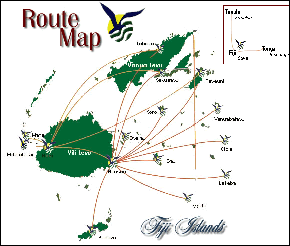
 Fiji Airports,
the Airports that never sleep Fiji Airports,
the Airports that never sleep |
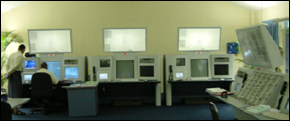
Fiji has been getting double-digit growths in visitor
arrivals the past two years and around the world,
not many countries can lay claim to such an impressive
gain and Fiji now even expects double-digit growth
to continue this year with the South Pacific Games
in Fiji in June/July and the rugby World Cup in
Australia in October. The unprecedented growth in
the number of visitor arrivals Fiji enjoys has awaken
Airports Fiji Limited to start building up their
security to be able to satisfy other countries,
particularly those whose airlines fly directly to
Fiji or from Fiji to their country as first destination.
"Whatever our security measures are will
have to be acceptable for countries like USA, Japan,
Australia, New Zealand or South Korea",
Mr. Jone Koroitamana, Chief Executive of Airports
Fiji Limited says. "These countries send
their security officers to check our security measures.
We are also looking at new machines to bring in
so that we can work towards meeting the requirements
of the International Civil Aviation Organisation
(ICAO)". Koritamana's vision is to set
Fiji Airports as the Gateway to the South Pacific,
"in order to be a major centre in the South
Pacific we have been improving our technology. The
new Air Traffic Management System is a method that
uses satellite technology as the world aviation
is moving from a ground based navigation system
to a satellite based navigation system. Fiji has
been very much involved in this technology from
the very beginning. In fact, we were the first country
in the world to approve the use of GPS for domestic
navigation purposes in 1994".
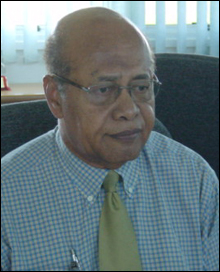
 The Master
Air Plan The Master
Air Plan |
The Nadi International Airport has not been upgraded
for many years so there was a need to bring it up
to international standards and enhance safety, security,
technology and efficiency. Koroitamana, who started
in the sector as an air traffic controller, explains
how the upgrading works are going: "We are
currently occupied with the first phase of the master
plan, the upgrading of the building. Most of it
will be completed this year and I can assure you
that we will be ready before the South Pacific Games.
We also have to extend the main runway but this
will be a totally separate project and it has to
be tendered out.We are looking at starting the pavement
work this year because there is a big demand by
Air Pacific to lengthen the runway so that they
can carry more freight to destinations like Japan
or USA". Concerning the Nausori Airport,
the airport in Suva, a limited upgrading of the
Nausori Airport terminal building will also be completed
by mid this year, "a new Control Tower and
Fire Service buildings will be constructed at Nausori
Airport soon". |
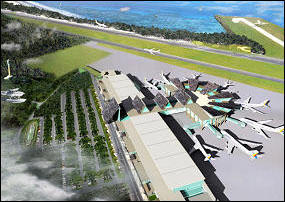
The current upgrading work can take Airports Fiji
Limited to the two million passengers mark, Mr.
Koritamana says, "before we reach that, we
need to be looking at where to from there. This
is where phase two of the master plan comes in.
We are not expecting any contribution from the government,
we have to concentrate on increasing our revenue
from non-aeronautical sources. This will be achieved
through the provision of more commercial spaces
in our future terminal building developments and
increase rentals due to improvements made to the
buildings". Last year, Airports
Fiji Limited revenue was of around $30 million
FJD and this year they are looking at around $40
million FJD (@ $20m USD). Fiji's tourism industry
will benefit enormously from the $25 million FJD
upgrade at Fiji's two international airports of
Nadi and Nausori (@ $12.5m USD). Carried out in
line with a master plan drawn up by Singapore Airport
Consortium - architect of Singapore's Changi International
- the upgrade will see more space for shops, restaurants
and internet cafes, faster processing of passengers
and other customer friendly initiatives.
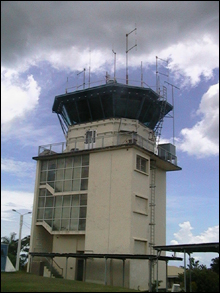
 Fiji Ports,
getting ready to handle the world Fiji Ports,
getting ready to handle the world |
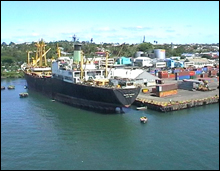
Fiji has good international shipping services as
well. Suva is the main port and its wharf facilities
handle large cargo and passenger vessels. The country
has three other declared ports of entry. The Maritime
and Ports Authority of Fiji administers the country's
ports. "There is a lot of merchandise that
goes thorough our economic zone into the South,
Australia and New Zealand," offers Joe
Singh, chairman of FTIB and of Maritime and Ports
Authority. "They are transshipped through
Fiji on to the South Pacific countries. I believe
there is an opportunity to capture here. It is a
chance to demonstrate the shippers and the shipping
industry that mega ships wanting to spend little
time between cargo loading and unloading will be
able to achieve this in Fiji. We are geographically
in a strategic position to take advantage of it."
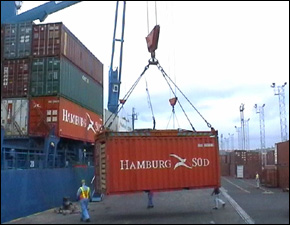
Ports Terminal Ltd. is the commercial arm and provides
handling and stevedoring services at the ports of
Suva, Lautoka and Levuka. The three ports handle
all types of cargo whether general cargo, dry bulk
or liquid bulk. Storage facilities are available
in Suva and Lautoka ports. Suva has 6 storage sheds
providing 12,200 square metres of storage whereas
Lautoka has three sheds providing 6,030 square metres
of storage. There are facilities for bonded and
transhipment cargo and inland freight stations are
operated to supplement the port storage space and
facilitate the removal of unclear cargo from the
wharves. Container cargo is also handled with Ports
Terminal boasting a fleet of cargo handling
equipment consisting of heavy duty forklift trucks,
tractors, mobile cranes and trailers. Ports
Terminal Ltd. Chairman, Mr.
Viliame Leqa, reckons a port depends on the
shipbuilders: "the future ships are bigger,
faster and with a state of the art technology, they
want to come in the dock, unload and take off. Neighboring
countries are smaller islands, a hub port is needed
in the Pacific and this is why we are improving
our infrastructure and our technology".
|

